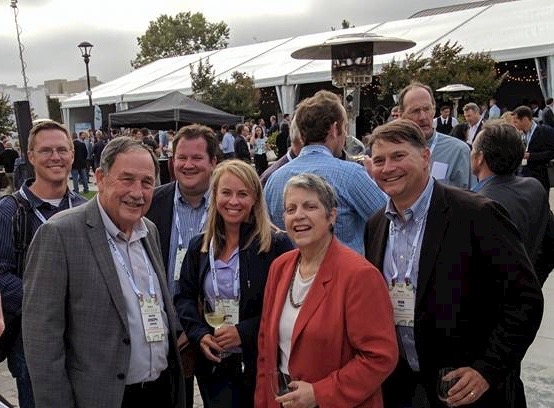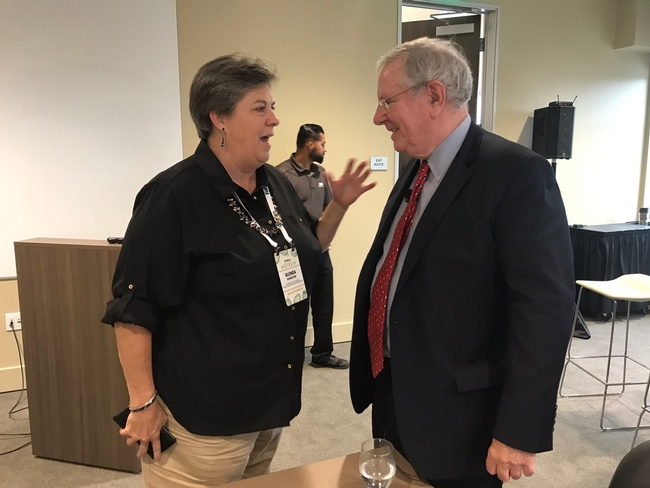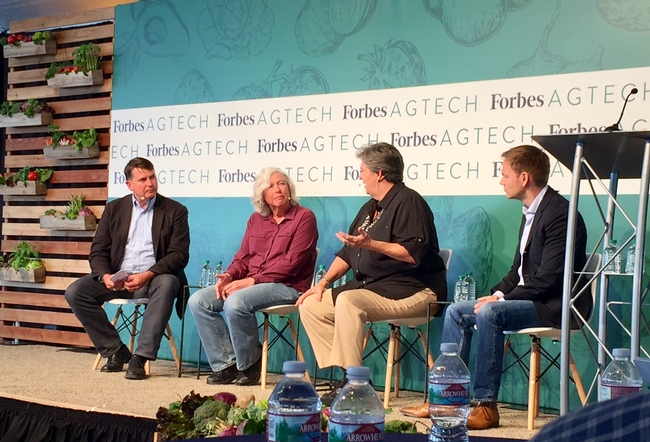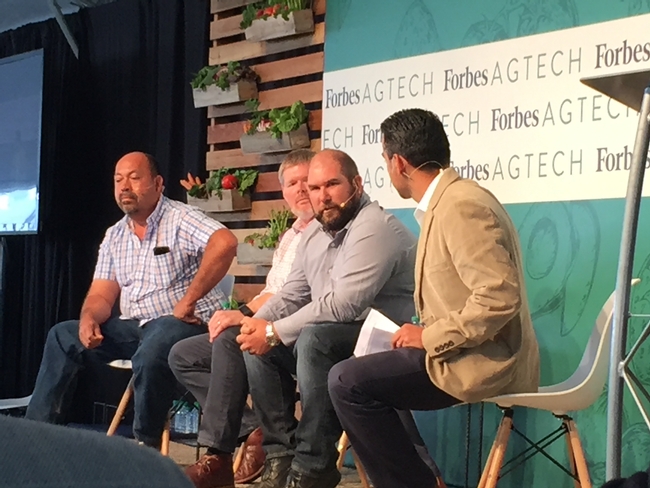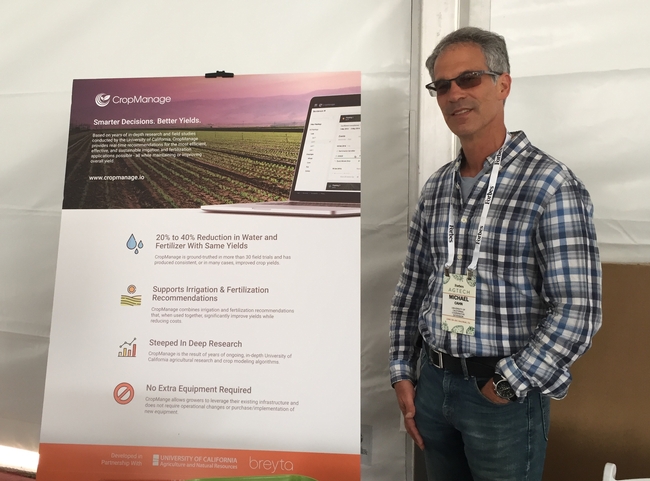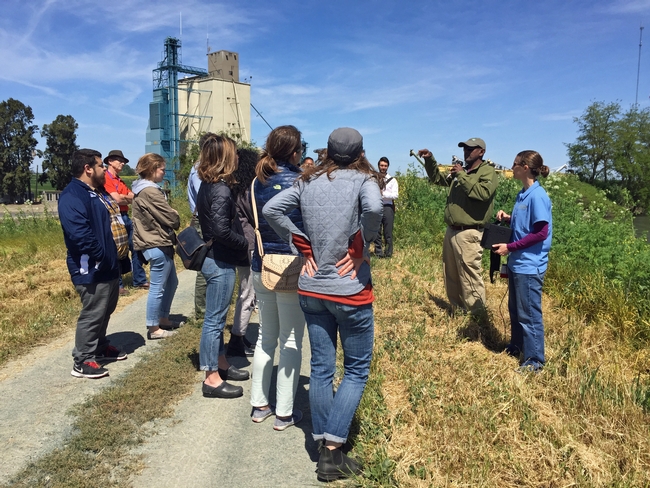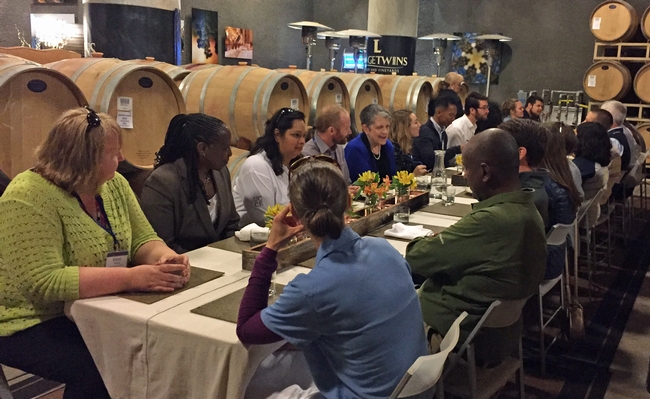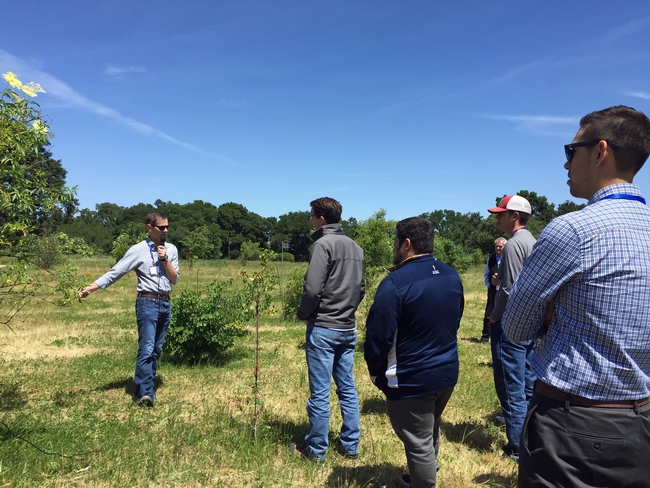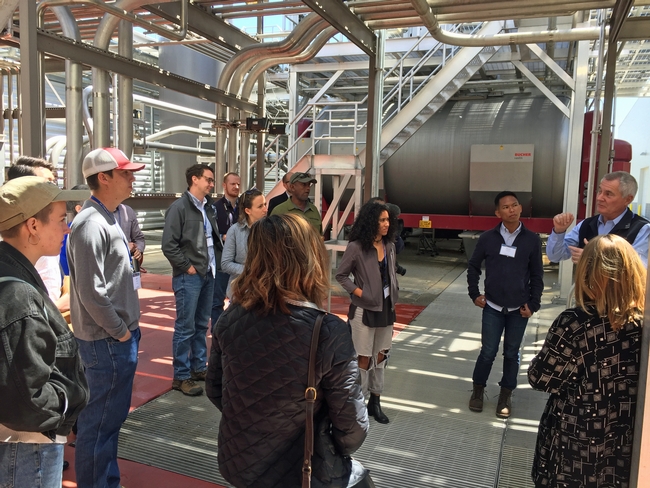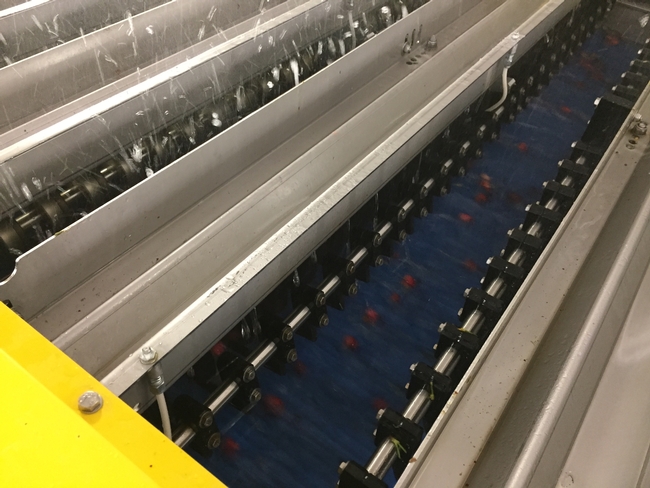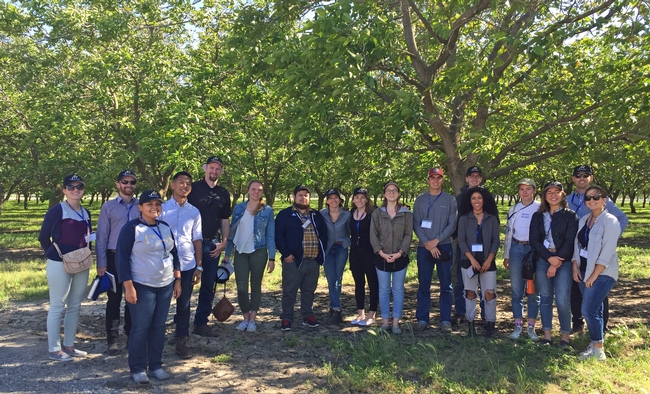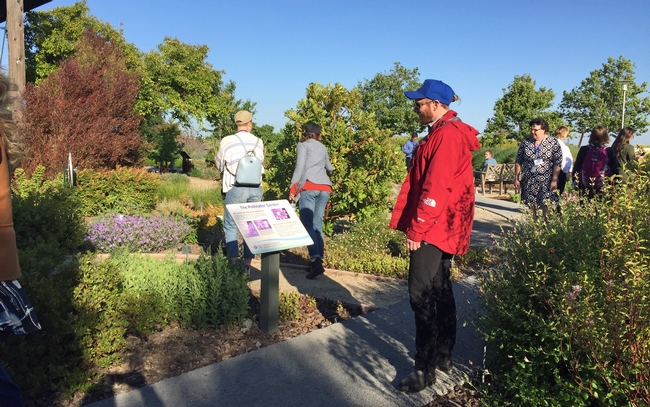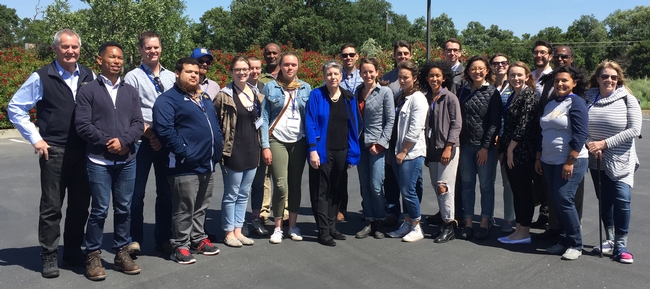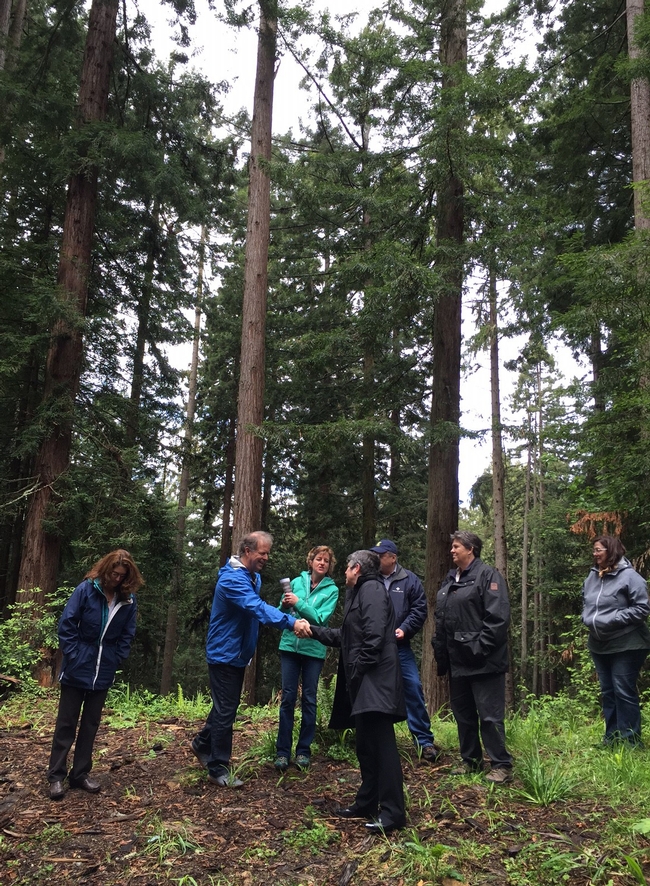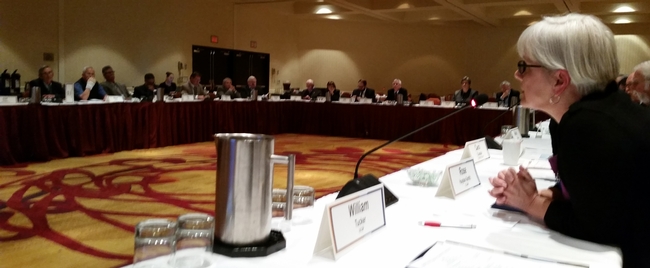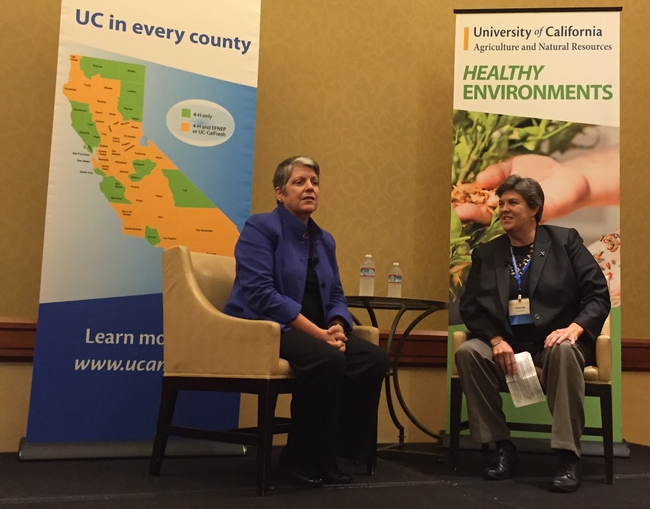Posts Tagged: Janet Napolitano
Tech meets ag at Forbes AgTech Summit in Salinas
“As we confront the problems in California today, we must ask ourselves, how will ag and tech solve these problems together? How can Salinas Valley and Silicon Valley work more harmoniously and how will the University of California's quest for new knowledge play a role?” said UC President Janet Napolitano to farmers, engineers, entrepreneurs and others attending the Third Annual Forbes AgTech Summit.
Silicon Valley, the birth place of high tech, converged with Salinas Valley, “the nation's salad bowl,” on June 28 and 29 in Salinas to explore opportunities to apply technology to agriculture's challenges. About 700 people participated in the invitation-only event, which was co-sponsored by the University of California and UC ANR.
“The Forbes AgTech Summit brings together individuals and institutions from two integral parts of California's economic engine — agriculture and technology,” Napolitano said. ”The two have historically remained on parallel paths, each fueling the state's growth, but rarely converging. Yet, this is a unique moment here in California, and we have a unique opportunity in this nexus of agricultural bounty and technological innovation.”
Steve Forbes, chairman and editor-in-chief of Forbes Media, told Farm to Table Talk podcast, “Knowledge comes from experimentation, constant discovery, which agriculture has been doing for well over 1,000 years. That pace in agriculture is increasing today. There's no reason why, if we don't do silly things, the world, even though population will grow by 2 billion in the next three decades, the world won't have sufficient food, more abundant and healthier food than we can even imagine today. Human ingenuity will do it.”
VP Glenda Humiston joined Sallie Calhoun, owner and manager of Paicines Ranch, and Trent McKnight, rancher and founder of Agricorps, to discuss challenges and opportunities to grow entrepreneurs in agriculture with moderator Rob Trice, co-founder and partner of The Mixing Bowl. McKnight said there is technology gap between rural and urban America. Humiston noted that poor access to high-speed broadband in rural regions could slow their adoption of technology.
In a four-minute video produced by Forbes, Humiston discusses challenges and opportunities for agriculture. She describes how The VINE, or The Verde Innovation Network for Entrepreneurship, is being launched by UCANR and led by Gabriel Youtsey, chief innovation officer, to cultivate regional innovation and entrepreneurship ecosystems in rural communities.
Between the rising cost of minimum wage, an aging working population and immigration crackdowns, farming is facing a worker shortage. Brian Antle of Tanimura & Antle, Dan Steere, co-founder and CEO of Abundant Robotics, and Javier Zamora, owner of JSM Organics, discussed with moderator David Mancera of Kitchen Table Advisors, how technology could perform work that people don't want to do. Antle pointed out that while machines can plant and cut, they cannot replace the judgment of skilled workers.
In her address, Napolitano explained UC's interest in agricultural technology.
“We started the UC Global Food Initiative three years ago to find scalable solutions to sustainably and nutritiously feed a growing world population — one that's expected to reach 8 billion people by 2025,” Napolitano said. “At the same time, for more than a hundred years, people at UC Agriculture and Natural Resources have equipped farmers across the state with the latest scientific and technological advances in agriculture.
“They connect cutting-edge innovation with the state's farmers, who produce half of the nation's fruit and vegetables and export food to countries around the world. And they are constantly generating and testing new ideas.”
See related news coverage:
Napolitano Says Ag Needs Technology
Greater collaboration between ag and tech coming
University of California kicks off Ag innovation program
Labor shortage in ag fueling technology
Delta farm tour gives GFI fellows a broader view of food system
The day-long tour, hosted by UC Agriculture and Natural Resources, began at a farm that is maintained to support wildlife in the breezy Sacramento-San Joaquin River delta region. The GFI fellows also viewed a habitat restoration project at LangeTwins Winery then watched freshly harvested cherries being processed at Morada Produce's packing plant. They wrapped up the day with a tour of a demonstration garden and a discussion of nutrition education at the UC Cooperative Extension office in Stockton.
UC President Janet Napolitano, who, along with UC's 10 chancellors, launched the Global Food Initiative in 2014, met with the 17 fellows for lunch at LangeTwins Winery.
“We started the Global Food Initiative several years ago with the goal of creating a pathway to a sustainable, nutritious food future for the planet. A small, modest goal,” Napolitano said, adding that she is excited to learn about the fellows' projects.
The GFI fellows are working on projects that range from raising awareness about food production to analyzing the effects of climate change on pollination, and from efforts to make soils safe for growing food in urban areas to using food waste to fuel batteries.
UC Merced senior Ever Serna's GFI project is to educate his fellow college students about where food comes from, before it gets to the grocery store.
“The tour gave me a deeper understanding and appreciation about how food is developed and grown,” he said. “I think when I eat vegetables and fruits, I'm going to be more conscious of what I eat now.”
Reid Johnsen, a third-year Ph.D. student in agricultural and resource economics at UC Berkeley, Global Food Initiative fellow for UC ANR, and participant in the Graduate Students in Extension program, is working with UC Cooperative Extension in Sonoma County to study ranchers' preferences for different payment structures for conservation easement to compensate them for the ecosystem services provided by their land.
“To be able to see agriculture in action makes such a difference to me, to see the way the crops are produced and the variety that's out here,” said Johnsen. “The diversity of crops was not something I was aware of before coming on this trip.”
“I thought it was interesting to see a lot of different agricultural production systems,” said UC Santa Barbara senior and campus GFI ambassador Bryn Daniel, who works with student activists on student food access and housing security issues.
In addition to learning more about food production, the outing gave the fellows an opportunity to network with peers from other campuses.
“That's what I liked about today's meeting, just meeting everybody and getting these fantastic connections,” said Ryan Dowdy, a third-year Ph.D. student at UC Davis who is converting food waste into energy-producing microbial fuel cells.
“I think this program, and especially the fellowship, is really important for young scientists who dive into this really huge subject of global food,” said Claudia Avila, a graduate student at UC Riverside who studies trace metals in urban agricultural soils.
Best kept secret
In welcoming the UC GFI fellows, Glenda Humiston, UC vice president for agriculture and natural resources, said, “I have a feeling a lot of you aren't familiar with our division. As I travel around the state to different campuses, I keep being told that we're the best kept secret, which I personally do not think is a good thing."
She explained that agricultural research has been part of the University of California since the land-grant institution's beginning in 1868 in Oakland. UC ANR has researchers on the Berkeley, Davis and Riverside campuses and UC Cooperative Extension advisors in the county offices, she said, adding, “Here in California, our advisors have very robust research programs.”
Farms are wildlife habitat
Michelle Leinfelder-Miles, UC Cooperative Extension delta crops advisor, and Brenna Aegerter, UCCE farm advisor in San Joaquin County, gave the fellows an overview of delta agriculture. Dawit Zeleke, associate director of conservation farms and ranches for The Nature Conservancy, explained why he farms 9,200 acres of corn, triticale, potatoes, alfalfa and irrigated pasture to enhance foraging habitat for sandhill cranes and other wildlife on Staten Island. The Nature Conservancy partners with UC Cooperative Extension along with the U.S. Fish and Wildlife Service, the U.S. Geological Survey, California Department of Water Resources, Oregon State University, UC Merced and UC Davis to study the relationships between agriculture and natural resources.
The Pacific Flyway for migrating birds passes over the delta. “Eighty percent of waterfowl depend on agriculture for food,” Zeleke said. After wheat harvest, they flood the fields. “You should see it in September, October, November and December. Thousands of birds, ten thousand cranes use this place for habitat.”
Lodi region is zin-ful
En route to lunch, Paul Verdegaal, UC Cooperative Extension viticulture advisor for San Joaquin County, described the Lodi region's wine industry. There are about 750 growers, many of which are small family operations. While 10 to 15 acres used to be typical vineyard size, most have 100 acres to be sustainable and one family member works at an outside job.
“Agriculture is a tough job and there is no guaranteed income,” Verdegaal said.
About 40 percent of the zinfandel in California is grown in the Lodi region, but there are several wine grape varieties planted.
Pointing out the bus window to a vineyard interplanted with a crimson clover cover crop, Verdegaal said, “We do see interest in using as few chemicals as possible and using techniques of the integrated pest management program.”
After eating lunch at LangeTwins Winery in Acampo, the GFI fellows took a tour of the winery with the fourth- and fifth-generation owners, Randy Lange and Aaron Lange. The Langes are founding members of the Lodi Rules Program, which helps growers produce grapes and wines in a manner that is environmentally respectful, socially sensitive and economically sound. They pointed out an array of solar panels covering the grape press room that provide electricity. The Langes are planting native plants around the winery to reduce sedimentation, improve water quality and restore wildlife habitat along the Mokelumne River.
Bing is king of cherries
When the GFI fellows visited at the end of April, sweet cherry harvest had just begun in Bakersfield area orchards, and cherries were being packed and shipped in San Joaquin County.
“Hemmed in by rain to the north and heat to the south, cherry season is only eight to 10 weeks long,” said Joe Grant, emeritus UC Cooperative Extension farm advisor for San Joaquin County.
“While the Bing variety is still the mainstay of the California cherry industry because of its excellent eating and shipping quality,” said Grant, “acreage of other high quality and earlier-maturing varieties has increased in recent years to lengthen the harvest season. But Bing is still king.” Asked about the effects of climate change on cherries, Grant explained that warmer temperatures are reducing the number of winter chilling hours, which cherries need.
The fellows saw the hand-picked fruit being processed for packing at Morada Produce, a family farm in Linden that also grows walnuts, peppers and onions.
“Keeping produce cold is key to maintaining quality,” said Scott Brown, Morada's production manager, as the fellows watched fresh, cold water rain down onto the freshly picked sweet cherries. The leaves and stems floating to the top were removed as the red clusters glided in the water to the cluster cutter, which gently separated the clusters into individual cherries. Gently conveyed through the plant in flowing water, the cherries were sorted by size and quality at the highly mechanized facility. Air ejectors spit out rejected fruit, so only 70 percent makes it into a packed box.
“Fruit picked on Monday is packed Tuesday, then shipped to Korea, Japan, Australia and other export markets to be eaten by Friday,” Brown said.
The fellows were fascinated to see the steps taken to ensure high-quality cherries are cooled, sorted and packaged for shipping to stores and consumers.
“It was just so much more complicated than I knew,” said Jess Gambel, a third-year Ph.D. student at UC San Diego who is studying the effects of climate change on bee pollination in squash plants.
Sustainable gardening
As the bus drove past almond orchards, Brent Holtz, UC Cooperative Extension director and farm advisor in San Joaquin County, described his orchard project studying the effects of removing almond orchards by grinding whole trees and incorporating them into the soil before replanting.
The tour wrapped up at the UC Cooperative Extension office in Stockton, with a discussion about how UC CalFresh and the Expanded Food and Nutrition Education Program help low-income Californians attain adequate nutrition and food security, followed by a tour of the demonstration garden maintained by the UC Master Gardener Program volunteers.
“There are more pollutants in urban runoff than in ag runoff,” said Karrie Reid, UC Cooperative Extension landscape horticulture advisor in San Joaquin County. Reid described how she and the UC Master Gardeners work with home and community gardeners to reduce pesticide and water use, and noted that a Water Use Classification of Landscape Species plant list, based on UC research, is available to help gardeners choose landscape plants.
“As a soil scientist, I really appreciated the recurring emphasis on soils as the foundation for agriculture,” said a fourth-year Ph.D. student at UC Berkeley and GFI fellow with Lawrence Berkeley National Laboratory. “From talking with The Nature Conservancy farm operator about how they were conserving carbon in those soils and doing wetlands management to hearing about special properties of the sandy loam soil in this part of the county, and talking with the Master Gardener folks about soil contamination issues.”
This is the third class of GFI student fellows. The undergraduate and graduate student fellows, representing all 10 UC campuses plus UC Agriculture and Natural Resources and Lawrence Berkeley National Laboratory, have helped further UC's Global Food Initiative efforts to sustainably and nutritiously feed the world's growing population by working on food-related projects and raising awareness of this critical issue.
Napolitano visits UCCE in Humboldt County
The university opened its first Cooperative Extension office in Eureka in 1913, but April 27 marked the first official visit to Humboldt County by a UC president.
“I hope to show the president how local residents benefit from UC Cooperative Extension and to give President Napolitano and Vice President Humiston ideas on how the university may get more involved in solving local challenges,” said Yana Valachovic, UC Cooperative Extension director and forest advisor for Humboldt and Del Norte counties, as the tour she organized got underway.
Valachovic introduced Napolitano and Humiston to community members at Potawot Health Village, where they learned about UC's nutrition education projects. Next, they boarded a boat with a shellfish producer and members of California Sea Grant, who briefed them on climate change research in Humboldt Bay.
At City of Arcata Community Forest, where UC has been conducting forest research since the 1920s, the City of Arcata environmental services director discussed how the city works with UC to manage its 2,300 acres of redwoods for timber, wildlife, water quality and to sequester carbon while providing recreational areas for city residents.
The president and Humiston ended the tour by reciting the 4-H pledge and listening to 4-H members and volunteers describe their projects.
To read more about the tour, visit http://ucanr.edu/?blogpost=21065&blogasset=52096.
PAC discusses UC president’s initiatives
Downtown Oakland was the site of December's biannual UC President's Advisory Commission on Agriculture and Natural Resources (PAC) meeting, which focused on President Janet Napolitano's Carbon Neutrality, Global Food, UC-Mexico and Innovation and Entrepreneurship initiatives, and the ways in which UC ANR can support them moving forward.
After opening remarks from UC ANR vice president Glenda Humiston, each of the Presidential Initiatives took center stage, with two-to-three person teams each offering brief presentations. The teams each included one or more UC ANR representatives, who spoke about the division's contributions – current and future – to the initiative in question.
Tapan Pathak, UC Cooperative Extension specialist for climate adaptation in agriculture (at UC Merced and the Sierra Nevada Research Institute), offered insights into what UC ANR is doing in regards to carbon neutrality. Pathak's expertise is focused on how the latest climate science can help agricultural producers reduce risks and enhance profitability.
On the UC-Mexico Initiative, Khaled Bali, UC Cooperative Extension advisor for irrigation and water management and director for Imperial County, spoke about UC ANR's collaborative research and education programs with Universidad Autonoma de Baja California in Mexicali. Mike Janes, UC ANR's strategic communications director, discussed the division's News and Information Outreach in Spanish operation in Riverside, noting the variety of communications products that office disseminates to California's Latino and Spanish-speaking populations that might be leveraged by the UC-Mexico initiative.
David Doll, UC Cooperative Extension advisor in pomology in Merced County, addressed UC ANR's work related to the UC Innovation, Entrepreneurship and Technology Commercialization Initiative. Among other data points, Doll alluded to the many patents and licenses generated by UC ANR throughout the years.
Finally, to demonstrate just one UC ANR activity that has successfully been supporting the Global Food Initiative, Rose Hayden-Smith, UC Cooperative Extension advisor for 4-H youth, family and community development in Ventura County, discussed the UC Food Observer blog she created in support of the GFI. She offered demonstrable evidence of the blog's vast reach and impact.
Following lunch, UC President Napolitano offered glowing remarks about UC ANR's contributions, not only to the Presidential Initiatives but to the UC system generally. She said she was committed to the division's growth and sustainability.
A series of updates followed from the deans of the UC Berkeley College of Natural Resources (Keith Gilless), the UC Davis College of Agriculture and Environmental Science (Helene Dillard), the UC Riverside College of Natural and Agricultural Sciences (Michael Anderson), and the UC Davis School of Veterinary Medicine (Michael Lairmore).
To give PAC members an opportunity to converse with the presenters about the initiatives informally, they concluded the meeting with a dinner reception at the nearby home of President Napolitano.
Presentations from Strategic Initiatives Conference now posted online
Posters, PowerPoints and videos of presentations from the UC ANR Joint Strategic Initiatives Conference in Sacramento are now online.
More than 350 people participated, with the greatest number attending the lunch conversation with President Janet Napolitano and VP Glenda Humiston. Among the topics Napolitano and Humiston discussed was ANR's role in the President's Initiatives, including Global Food, UC-Mexico and Carbon Neutrality.
If you attended the conference and haven't already evaluated the conference, send your comments by completing an anonymous survey. Your input is instrumental in understanding what was done well and what can be improved.
Videos of trainings, PowerPoint presentations and posters have been linked to the conference website:
- Some of the in-service trainings were recorded. To listen to the speakers deliver their presentations and view their PowerPoints, visit the In-service Trainings website and click on “Video” under each presentation. Not all of the trainings were recorded.
- PDF files of Tuesday's highlighted presentations PowerPoints have been added online. Click the titles in the online conference agenda (not the PDF) to view the description for each presentation and to open the PDFs.
- PDFs of posters displayed at both of the receptions are posted. Poster presenters, if you do not see your file, please send it to ANR Program Support so it can be added.

